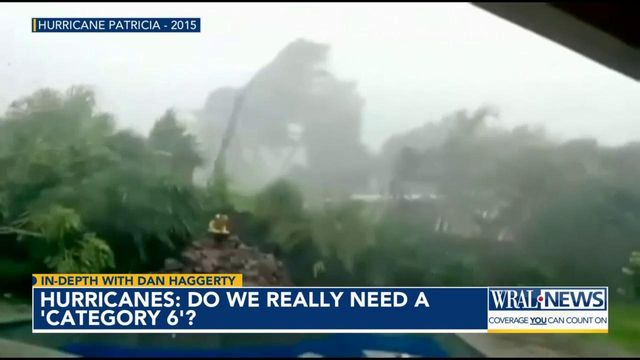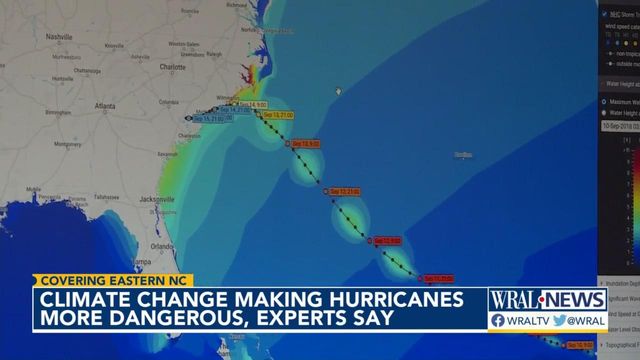Should we fear Category 6? Meteorologists weigh in on proposed hurricane scale expansion
A handful of super powerful hurricanes in the last decade and the possibility of more in the future has led some experts to propose another category of major hurricanes: Category 6.
Studies have shown that the strongest hurricanes are getting more intense because of climate change.
So, the traditional five-category Saffir-Simpson scale, developed in 1971, may not show the true power of the most muscular storms, two climate scientists suggest in a Monday study in the Proceedings of the National Academy of Sciences. They propose a sixth category for storms with winds that exceed 192 miles per hour.
Here is how the National Oceanic and Atmospheric Administration's National Hurricane Center currently breaks down the Saffir-Simpson scale:
- Category 1: 74-95 mph sustained winds: Very dangerous winds will produce some damage
- Category 2: 96-110 mph sustained winds: Extremely dangerous winds will cause extensive damage
- Category 3 (major): 111-129 mph sustained winds: Devastating damage will occur
- Category 4 (major): 130-156 mph sustained winds: Catastrophic damage will occur
- Category 5 (major): 157 mph or higher sustained winds: Catastrophic damage will occur ("a high percentage of framed homes will be destroyed)
“I don’t think that we do need a category 6 in the near future, and I don’t think that anybody who’s watching me right now should be scared by this study,” WRAL meteorologist Kat Campbell said. “Of the five hurricanes that would have reached the hypothetical category 6 status, none were in the Atlantic basin.
“Only one was in the [East Pacific], and it was only a category 6 over water. The majority were typhoons, and other parts of the world have their own scales, so adding a category 6 to our scale wouldn’t really matter to them.”
Campbell said she doesn’t expect NOAA to add a category 6 to the Saffir-Simpson scale anytime soon.
“NOAA is a government agency, so change takes a lot of time,” Campbell said. “I think this is something worth revisiting in the future but not worth acting on or prioritizing right now.”
National Hurricane Center Deputy Director Jamie Rhome echoed Campbell's sentiments about the possibilty of changes to the Saffir-Simpson scale.
"To be honest, I think scales are something we've done in the past, and we are not looking at any changes to the scale," Rhome said in an interview with meteorologist Ryan Phillips with NBC 6 in Miami. "We are focused on communicated risks that come with these particular storms."
Only five storms have hit 192 mph winds or more:
- 2013's Haiyan, which killed more than 6,300 people in the Philippines.
- 2015's Hurricane Patricia, which hit 215 mph (346 kph) before weakening and hitting Jalisco, Mexico.
- 2016's Typhoon Meranti, which reached 195 mph before skirting the Philippines and Taiwan and making landfall in China.
- 2020's Typhoon Goni, which reached 195 mph before killing dozens in the Philippines as a weaker storm.
- 2021's Typhoon Surigae, which also reached 195 mph before weakening and skirting several parts of Asia and Russia.
As the world warms, conditions grow more ripe for major hurricanes, including in the Gulf of Mexico, where many storms that hit the United States get stronger, the study authors said.
“Climate change is making the worst storms worse," said study lead author Michael Wehner, a climate scientist at the Lawrence Berkley National Lab.
It's not that there are more storms because of climate change. But the strongest are more intense. The proportion of major hurricanes among all storms is increasing and it's because of warmer oceans, said University of Miami hurricane researcher Brian McNoldy, who wasn't part of the research.
Campbell mentioned that people need to consider much more than just the category of a storm.
“I think it’s interesting to start the conversation but the greater and more pressing issue, in my opinion, is the lack of storm surge and flooding being considered when deciding the category of a hurricane,” Campbell said. “In a warmer climate, hurricanes aren’t just getting stronger, but they are also slowing down and leading to more flooding, and … water is by far the deadliest part of a hurricane, so we need to prioritize the messaging here.”











